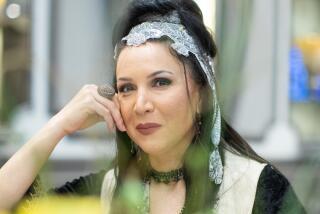C’mon, sing along with Bijan
- Share via
Very few artists reach the exalted level of popularity at which a single name is enough to identify them: Satchmo, Sting, Madonna, Shakira, Bijan. Although the last entry on that list won’t ring bells for most American music fans, it was enough to draw a capacity crowd of enthusiastic listeners to the Gibson Amphitheatre at Universal Studios on Wednesday night.
Bijan, whose surname is Mortazavi, is one of Iran’s biggest musical stars, and it’s a fair bet that the crowd was mostly Iranian as well, since barely a word was spoken or sung in anything other than Farsi. But Bijan, like every international artist with a singular name, performs at a level well beyond the specificity of language.
Although he was surrounded by a panoply of musicians and singers, and an ever-shifting display of spectacular lighting, he was, characteristically, a calm, even modest performer. Garbed in a less-than-superstar outfit of brown jacket, shirt and pants, he sang, played the violin and guitar and chatted amiably between numbers.
Bijan’s vocals were intimate, easily communicating the inner feelings of his songs even to those unfamiliar with (or uncomprehending of) the words. Well aware of his connection with his audience, he frequently held out the microphone to allow the crowd to sing the choruses of particularly well-known numbers -- many from his albums “Sweet Scent of Love” and “Voice of Silence.” His violin work alternated fiery passion with rich balladry, the songs often simmering with references to traditional Persian music. And he topped off his versatile presentation with guitar playing tinged with lute-like coloration.
Bijan’s set was a dramatic contrast to the rock concert-styled opening performance by the brother team of Kamran & Hooman. Based in Los Angeles, the dynamic duo are quickly establishing themselves as major Iranian stars.
Singing numbers from their first solo album, “20,” they jauntily strode the stage, often accompanied by a vigorous, tightly choreographed team of dancers and tumblers. The opening of their set, which featured a brief appearance by samba school percussionists, set the tone for a performance fusing Caribbean and Mediterranean rhythms with boy-band melodies, invigorated by spectacular bursts of flames and fireworks.
Like Bijan, Kamran & Hooman’s music underscored the growing emergence of a universal, beyond-boundary genre of world music.
More to Read
The biggest entertainment stories
Get our big stories about Hollywood, film, television, music, arts, culture and more right in your inbox as soon as they publish.
You may occasionally receive promotional content from the Los Angeles Times.










